
The German chemical company BASF once used this slogan: “At BASF, we don’t make a lot of the products you buy. We make a lot of the products you buy better.” That’s kind of what gamification does. It doesn’t make your offering; it makes your offering better. And it has done so for a number of businesses.
In short, yes, gamification works. That being said, gamification is not a panacea for your business woes. If your business or product is lousy, or if you’re at the bottom of a dying industry, gamification alone can’t save you. People look for value; if your value proposition stinks, gamification won’t make it smell like roses.
The world’s largest social network for MBA applicants, BTG launched a social network called MBA Watch as part of its effort to build a high-quality community of MBA candidates. In an attempt to motivate and influence users to share insights and knowledge techniques in solving problems, BTG used various gamification techniques, including badges and leaderboards. The results:
- A 195% increase in pages visited
- A 370% increase on time spent on site
- 50,000 activities performed by 8,000 users
the Canadian equivalent to MTV, received millions of visitors each year on its website. But Much needed a way to foster more repeat visits. Enter gamification. Using game mechanics, Much began rewarding visitors for performing such actions as signing up, leaving a comment, uploading content, voting on polls, and so on. The company also devised various missions to generate engagement with specific shows and campaigns. The results:
- In the first month, more than 23,000 users created accounts on the site — a 21% increase, with nearly one in three returning daily.
- More than 325,000 behaviors were rewarded.
- Nearly 120,000 achievements were unlocked.